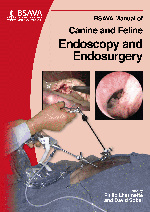
Full text loading...

PLEASE NOTE THAT A MORE RECENT EDITION OF THIS TITLE IS AVAILABLE IN THE LIBRARY
Flexible endoscopy of the respiratory tract can be a valuable therapeutic, diagnostic and prognostic tool for most patients with respiratory disease. Endoscopy can be used for diagnostic evaluation of the airways, including the nasal passages, nasopharynx, dorsal soft palate, pharynx, larynx, trachea and pulmonary tree, and to assess laryngeal function. Collection of tissue and fluid samples can be performed for microbiological or histopathological evaluation. The bronchoscope is also available as a valuable therapeutic tool and can be used to remove foreign objects from the pharynx, trachea and bronchi. It can also be used to place and evaluate airway stents. Visualization of airway injury or chronic airway changes can be monitored over time and will aid in determining the prognosis of conditions. Bronchoscopy is most rewarding when the veterinary surgeon has a good understanding of airway anatomy, use of equipment, anaesthetic protocols and techniques. This chapter covers Indications; Instrumentation; Premedication and anaesthesia; Patient positioning; Procedure; Pathological conditions; Foreign body removal; Postoperative care; and Complications.
Flexible endoscopy: respiratory tract, Page 1 of 1
< Previous page | Next page > /docserver/preview/fulltext/10.22233/9781905319572/9781905319572.6-1.gif

Full text loading...


























